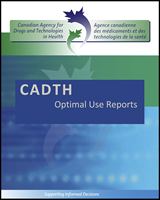Except where otherwise noted, this work is distributed under the terms of a Creative Commons Attribution-NonCommercial-NoDerivatives 4.0 International licence (CC BY-NC-ND), a copy of which is available at http://creativecommons.org/licenses/by-nc-nd/4.0/
NCBI Bookshelf. A service of the National Library of Medicine, National Institutes of Health.
The objectives of this project are to:
- Identify and appraise the clinical and cost-effectiveness evidence pertaining to use of atypical antipsychotic (AAP) combination and high-dose treatment strategies in the defined population and to develop evidence-based optimal use recommendations for these strategies.
- Identify current utilization of AAP combination and high-dose treatment strategies in Canada.
- Identify current practices of physicians and patients regarding the use of AAP combination and high-dose treatment strategies in Canada.
- Identify differences (i.e., the gaps) between optimal prescribing and use of AAP combination and high-dose treatment strategies, as well as actual current utilization and practice.
- Identify potential barriers to optimal use of AAP combination and high-dose treatment strategies.
- Identify key messages to encourage optimal prescribing and use of AAP combination and high-dose treatment strategies.
- Identify effective activities and strategies (interventions), which could be directed toward a variety of audiences such as health and allied health professionals, patients, or government decision-makers, to encourage optimal prescribing and use of AAP combination therapy and high-dose treatment strategies.
- Develop intervention tools to support optimal prescribing and use of AAP combination therapy and high-dose treatment strategies.
- Support implementation of tools and evaluation.
- Develop evaluation mechanisms to measure the impact of intervention tools.
Contents
- Contributors from CADTH
- COMPUS Expert Review Committee
- Members
- Specialist Expert Members
- Conflicts of Interest
- ABBREVIATIONS
- 1. INTRODUCTION
- 2. ISSUE
- 3. OBJECTIVE
- 4. PROJECT OVERVIEW
- 5. RESEARCH QUESTIONS
- 6. METHODS
- 7. EXECUTION OF THE PROJECT
- 8. DELIVERABLES
- REFERENCES
- APPENDIX 1 Literature Search Strategy
- APPENDIX 2 Overview of Process for Assessing the Applicability of Existing Systematic Reviews and Meta-analyses
- APPENDIX 3 SIGN 50* — Randomized Controlled Trial Quality Assessment Tool
This report is prepared by the Canadian Agency for Drugs and Technologies in Health (CADTH). This report contains a comprehensive review of existing public literature, studies, materials, and other information and documentation (collectively the “source documentation”) available to CADTH at the time it was prepared, and it was guided by expert input and advice throughout its preparation.
The information in this report is intended to help health care decision-makers, patients, health care professionals, health systems leaders, and policy-makers make well-informed decisions and thereby improve the quality of health care services.
The information in this report should not be used as a substitute for the application of clinical judgment in respect of the care of a particular patient or other professional judgment in any decision-making process, nor is it intended to replace professional medical advice. While CADTH has taken care in the preparation of the report to ensure that its contents are accurate, complete, and up-to-date, CADTH does not make any guarantee to that effect. CADTH is not responsible for any errors or omissions or injury, loss, or damage arising from or as a result of the use (or misuse) of any information contained in or implied by the information in this report.
CADTH takes sole responsibility for the final form and content of this report. The statements, conclusions, and views expressed herein do not necessarily represent the views of Health Canada or any provincial or territorial government.
Production of this report is made possible through a financial contribution from Health Canada.
This document may contain links to other information available on the websites of third parties on the Internet. CADTH does not have control over the content of such sites. Use of third-party sites is governed by the owners’ own terms and conditions set out for such sites. CADTH does not make any guarantee with respect to any information contained on such third-party sites and CADTH is not responsible for any injury, loss, or damage suffered as a result of using such third-party sites.
